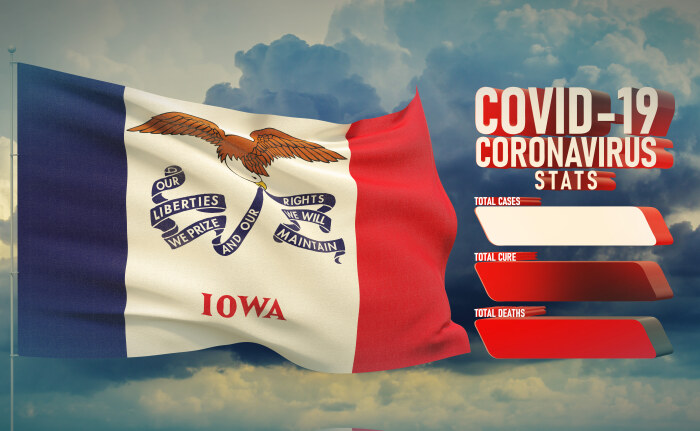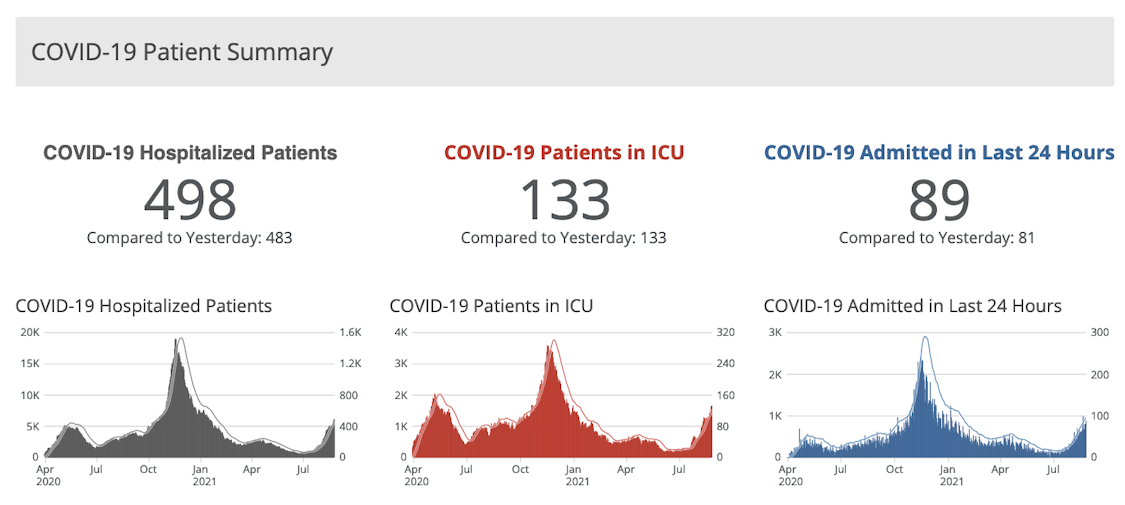COVID-19 case counts and hospitalizations continue to accelerate in Iowa, reaching levels not seen for many months. Data published on the state’s official website on August 25 show Iowa reported 7,112 new coronavirus cases over the previous week. The last time the state averaged 1,000 new cases a day was in late January.
Statewide, 498 Iowans are now hospitalized with COVID-19, an increase of 25 percent from the 396 reported on August 18. The last time this many Iowans were hospitalized with coronavirus was in mid-January. The number of patients being treated for the virus in intensive care units (133) is at its highest level since late December 2020. Iowa also reported 89 new daily admissions for COVID-19 on August 25, the highest level since mid-January.
Hospitalizations have risen sharply this summer, quadrupling in the last month alone. Current numbers are ten times higher than the low point for Iowa’s COVID-19 hospitalizations in late June.
The slope of this past month’s increases resembles what happened in Iowa last October, as you can see from graphs published on the RMCC Data page of the state’s website. Total hospitalizations and new daily admissions are now approximately where they were on October 20, 2020.
The real number of Iowans hospitalized with COVID-19 is likely higher. Data tracker Sara Anne Willette reported that according to federal government databases, Iowa had 484 hospitalized patients with “confirmed” cases and another 95 with “suspected” infections on August 25. Willette has created many more graphs and tables showing hospitalization trends at her Iowa COVID-19 tracker website.
During 2020, Iowa’s coronavirus hospitalizations crept up over the summer and began increasing rapidly in late September. That was with no Iowa State Fair and most K-12 schools requiring masks for students and staff.
Iowa State Fair attendance topped 1 million this year, and hundreds of thousands of (mostly unvaccinated) children returned to Iowa schools this week, with schools unable to require masks or use other mitigation practices employed last year. Meanwhile, the Delta variant is much more transmissible than the strains of COVID-19 circulating in Iowa in 2020.
Since hospitalizations typically lag new cases by one to three weeks, only a small fraction of Iowans infected at the state fair and no one who caught the virus at school would be among the nearly 500 now being treated for COVID-19 in the hospital.
Iowa’s coronavirus deaths are also trending upward. The state website confirms 58 fatalities already in August, based on the dates on death certificates. Only 44 Iowans died of the virus during the entire month of June. The state reported 49 deaths occurring in July; numbers for July and August will rise considerably in the coming weeks. It usually takes a few weeks to confirm an Iowan died of COVID-19 and can take months.
LOCAL HEALTH OFFICIALS ALARMED
The Polk County Health Department warned in an August 24 news release that COVID-19 cases and hospitalizations were “surging.” (emphasis in original)
“Our months of incredibly hard work are quickly being undone,” said Joshua Akers, Polk County Medical Examiner. “The first full week of August we saw seven COVID-19 related deaths and the numbers are continuing to rise. What is also concerning is that we are beginning to see the average age of decedents getting younger.”
Over the past three weeks, we have seen 175% increase in COVID-19 hospitalizations. Today, our hospitals have 109 COVID-19 patients. We have not seen a trend in COVID-19 hospitalizations like this since the last COVID-19 surge, which took place in October of 2020. Of the 109 COVID-19 patients, four of those are under the age of 18. While four may seem like a small number to most, this is the highest number of under 18 COVID-19 hospitalized patients we have ever seen throughout the pandemic. Polk County hospitals are operating at limited capacity. Currently, Blank Children’s Hospital has canceled elective surgeries and other metro hospitals are monitoring daily cases and canceling some elective surgeries.
Finally, our COVID-19 cases from the past weekend has increased 87% since the first weekend in August. During the month of July 2021, Polk County was averaging 31 COVID-19 cases a day. As of August 22, 2021, we are averaging 120 COVID-19 cases a day. We expect our COVID-19 cases in Polk County will continue to surge since school has started and individuals are not following COVID-19 prevention strategies, including wearing masks in public indoor settings.
Linn County Public Health officials told reporters this week that while the majority of severely ill patients are unvaccinated, they have seen an increase in hospitalization numbers even for vaccinated people. They are recommending the same mitigation practices other health experts have suggested for months: “get vaccinated, wear a mask, socially distance, stay home if they’re sick, and keep their students home when they’re sick.”
Meanwhile, state officials continue to put all their eggs in the vaccination basket.
LATEST STATE RELEASE FAILS TO MENTION MASKS
The Iowa Department of Public Health put a favorable spin on the trends in a statement issued August 25. The news release (enclosed in full below) asserted that thanks to the COVID-19 vaccination campaign, “current numbers are a fraction of what they were in November 2020, when the state experienced its highest level of virus activity.”
Yes, but we didn’t have the Delta variant then, and schools were able to reduce spread in ways that are off the table now.
The IDPH omitted face coverings from a list of “a number of things Iowans can do to protect themselves and others from COVID-19 and prevent spreading the virus in their communities.” In addition to vaccination, the news release mentioned ways to “get tested” and “seek treatment.”
Asked why the public health agency was no longer encouraging masks (even in crowded indoor settings) to reduce virus spread, spokesperson Sarah Ekstrand told Bleeding Heartland via email on August 25,
IDPH has always emphasized the importance of using the tools available to protect Iowans from the spread of the COVID-19 virus including masks, washing hands frequently, staying home when sick and social distancing. Most importantly, the vaccine is the best way to protect ourselves and others from the virus and we encourage everyone to get vaccinated.
Hundreds of thousands of Iowans are not eligible for vaccinations, because they are under age 12. Most of those children are now spending their days surrounded by unmasked, unvaccinated classmates. The IDPH no longer recommends that schools encourage mask wearing, saying in current guidance only that schools should allow students or staff to voluntarily wear a face covering.
If the IDPH team were really “emphasizing the importance” of using all tools available to reduce community transmission of COVID-19, they would have mentioned face coverings in their latest news release.
If state officials were serious about getting this surge under control, they would resume daily reporting of COVID-19 statistics. From every angle, the numbers are considerably worse than they were in early July when IDPH switched to weekly website updates.
Full text of August 25 news release from the Iowa Department of Public Health:
(Des Moines, IA) Like most of the country, Iowa has experienced an increase in COVID-19 cases, hospitalizations and deaths in recent weeks.
Because of the success of our vaccine campaign, current numbers are a fraction of what they were in November 2020, when the state experienced its highest level of virus activity.
The majority of current COVID-19 hospitalizations are among unvaccinated Iowans. On August 25, 79% of individuals hospitalized with a primary COVID-19 diagnosis were not vaccinated and 86% of patients in the ICU were not vaccinated before becoming infected. The hospitalization rate is currently highest among middle age to older adults. 87% of those hospitalized are age 40 and older. Children under the age of 18 account for just 2% of COVID-19 hospitalizations.
“We have many tools we need to keep ourselves and our loved ones safe and the single most important tool we have is the vaccine, which is highly effective at preventing serious illness, hospitalization and death. For anyone who was waiting for the assurance of full FDA authorization, I urge you to schedule your appointment today,” shared Iowa Department of Public Health interim director Kelly Garcia.
Preventing avoidable COVID-19 hospitalizations also helps preserve health care resources for other needs, including illnesses, injuries and emergencies. Some Iowa hospitals have recently reported an increase in hospitalizations among children with RSV, limiting their bed capacity for other patients.
Today, the Iowa Department of Public Health is reporting 42 additional deaths due to COVID-19. These deaths occurred over a four-week period from July 24-August 22, 2021.
There are a number of things Iowans can do to protect themselves and others from COVID-19 and prevent spreading the virus in their communities:
Get vaccinated
According to the CDC, over 60% of Iowans 12 and older are fully vaccinated and there have been recent increases daily vaccine administration rates.
All Iowans over the age of 12 are eligible to get the COVID-29 vaccine. Vaccines are free, safe and available statewide. Find a vaccine provider at vacccinateiowa.gov. Iowans with questions about the vaccine should contact their healthcare provider. Click here for information on who is currently eligible for an additional dose of the COVID-19 vaccine.
Get Tested
If you or a loved one are experiencing COVID-19 symptoms, get tested as soon as possible. Symptoms may include coughing, shortness of breath, fever, chills, headache, muscle pain, sore throat, or loss of taste or smell. Testing is widely available with many convenient options.
Iowans can access testing at the following locations:
- Primary Care Providers
- Urgent Care
- Local and national pharmacies
- Private labs in local communities
Test Iowa At Home:
IDPH and the State Hygienic Lab are partnering to provide Iowans free at-home test kits. These test kits are ideal for a proactive diagnosis. Examples of proactive testing:
- Before upcoming travel, or returning from travel.
- Ensuring negative status before attending events.
- Recent COVID-19 positive and want to ensure a negative result before returning to normal activities.
- To have on hand for family members in case of exposure.
Go to testiowa.com for more information, to order a test kit or find a pick-up site near you.
Iowans are urged not to visit a Hospital Emergency Room for COVID-19 diagnostic testing, unless experiencing severe symptoms. An ER visit may expose others in a medically fragile state to the virus as well as place additional strain on hospital resources.
Seek Treatment
If you are diagnosed with COVID-19, you may be able to reduce the severity of your symptoms and prevent bad outcomes by receiving Monoclonal Antibodies. These antibodies can reduce the amount of virus in your body. Monoclonal Antibodies do not contain the virus that causes COVID-19. It’s important to do this before your symptoms progress to ensure the best possible outcome. Talk with your healthcare provider about whether this is the right option for you. Find options near you by visiting here.
While there are multiple tools available to prevent the spread of COVID-19, the vaccine remains the strongest and Iowans should get vaccinated as soon as possible.



No Comments